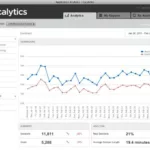Analytics are great for any web developer but they don’t mean much if you don’t understand them, use them, and ultimately act upon them. Page views, unique visitors, bounces and the thousands of other metrics available can tell you a lot about traffic to and through your site but you need to actually do something with those numbers if you want them to work for you.
Someone once said ‘data is something you store, information is something you use’ and that certainly applies to analytics. There are dozens of analytics services out there and they’ve grown quite sophisticated over the years. You can get charts and graphs and overlays and a million other bits and pieces of information about web traffic but sometimes it can be a bit overwhelming (and in some cases downright misleading).
I ran across some interesting blog posts written by Avinash Kaushik (you can find his ‘Occam’s Razor’ posts at www.kaushik.net/avinash/). Avinash is an author of two books “Web Analytics 2.0” and “Web Analytics: An Hour A Day”, he’s a consultant, speaker and he has been writing about marketing and analytics since 2006. His blog posts are insightful and well worth reading. (They are also fun to read, even if there are the occasional typos and odd bit of profanity here and there.)
The best thing about Avinash’s posts, however, is the fact that he is a firm believer in gathering the right information, interpreting that information in the context of your particular site or situation, and then doing something about it.
I get the feeling that weekly analytics reports, no matter how well they are prepared or how slick they are presented, would drive Avinash crazy because most of the time they are just pages filled with numbers. He wants you to do something with those numbers, act upon them, use them as tools to help improve your website and marketing, and ultimately profit from those changes.
In just about every post he talks about what specific analytics mean in different situations, which ones are more or less important, and then he talks about how to use those numbers to make changes that will further your goals, whether it’s a blog page, an e-commerce site, or a non-profit site.
In a recent post ‘Best Metrics For Digital Marketing: Rock Your Own And Rent Strategies’ (you can read the entire blog here) he talks about the importance of looking at the entire journey a potential customer would take and suggests you can break that journey into three stages; Acquisition, Behavior, and Outcome.
He also talks about the differences between assets that you own versus assets that you rent and which analytics are most meaningful in each situation. For example assets you own would be your website and your mobile applications. For assets you rent he breaks them down to into permanent (such as YouTube) and temporary (such as Facebook, Google+, Twitter, etc.).
For each type of asset he suggests two metrics to look at for each stage of the customer journey and why they are most meaningful. In total he picks 15 different metrics to measure just about everything a digital business needs to know about. Fifteen may sound like a lot but there are hundreds of metrics out there and it isn’t always clear which are most important.
As Avinash says at the end of the post ‘It is our ability to identify the critical few spectacularly relevant metrics to focus on that will bring personal glory to us and professional glory to our business.’








